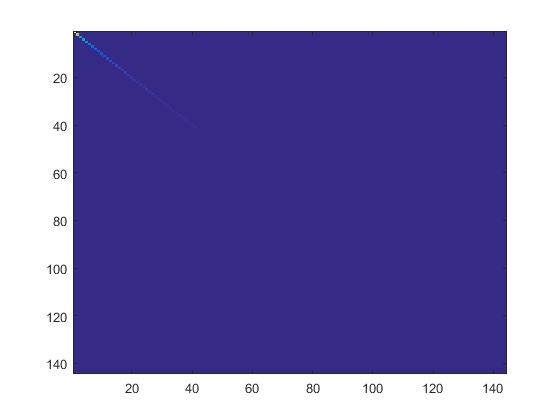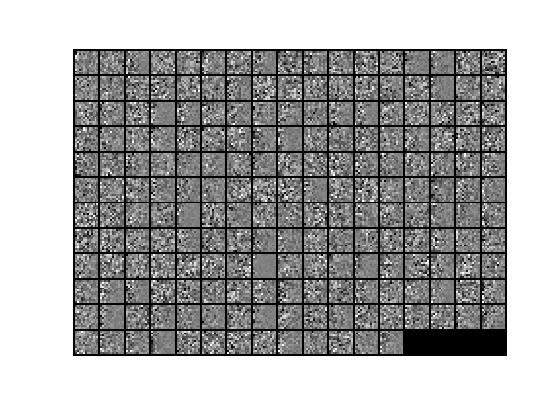Deep Learning 5_深度学习UFLDL教程:PCA and Whitening_Exercise(斯坦福大学深度学习教程)
前言
本文是基于Exercise:PCA and Whitening的练习。
理论知识见:UFLDL教程。
实验内容:从10张512*512自然图像中随机选取10000个12*12的图像块(patch),然后对这些patch进行99%的方差保留的PCA计算,最后对这些patch做PCA Whitening和ZCA Whitening,并进行比较。
实验步骤及结果
1.加载图像数据,得到10000个图像块为原始数据x,它是144*10000的矩阵,随机显示200个图像块,其结果如下:

2.把它的每个图像块0均值归一化。
3.PCA降维过程的第一步:求归一化后的原始数据x的协方差矩阵sigma,然后用svd对sigma求出它的U,即原始数据的特征向量或基,再把x投影或旋转到基的方向上,得到新数据xRot。
4.检查PCA实现的第一步是否正确:只需要把xRot的协方差矩阵显示出来。如果是正确的,就会显示出一条直线对角穿过蓝色背景的图片。结果如下:

5.根据要保留99%方差的要求计算出要保留的主成份个数k。
6.PCA降维过程的第二步:保留xRot的前k个成份,后面的全置为0,得到数据xTilde,基U乘以数据xTilde的前k个成份(即:前k行)就得降维后数据xHat。xHat显示结果如下:

为了对比,有0均值归一化后未降维前的数据显示如下:

7.对0均值归一化后的数据x实现PCA Whitening,得到PCA白化后的数据xPCAWhite,其显示结果如下:

8.检查PCA白化是否规整化:显示数据xPCAWhite的协方差矩阵。如未规整化,则数据xPCAWhite的协方差矩阵是一个恒等矩阵;如已规整化,则数据xPCAWhite的协方差矩阵的对角线上的值接近于1且依次变小。所以,如未规整化,把epsilon置为0或接近于0,就会得到一条红线对角穿过蓝色背景图片;如已规整化,就会得到就会得到一条从红色渐变到蓝色的线对角穿过蓝色背景的图片。显示结果如下:

9.在PCA Whitening的基础上实现ZCAWhitening,得到的数据xZCAWhite=U* xPCAWhite。因为前面已经检查过PCA白化,而zca白化是在pca的基础上做的,故这一步不需要再检查。ZCA白化的结果显示如下:

对比PCA白化结果,可以看出,ZCA白化更接近原始数据。
与其相对应的归一化原始数据显示如下:

代码
pca_gen.m
close all;
% clear all;
%%================================================================
%% Step 0a: Load data
% Here we provide the code to load natural image data into x.
% x will be a * matrix, where the kth column x(:, k) corresponds to
% the raw image data from the kth 12x12 image patch sampled.
% You do not need to change the code below. x = sampleIMAGESRAW();
figure('name','Raw images');
randsel = randi(size(x,),,); % A random selection of samples for visualization
display_network(x(:,randsel)); %%================================================================
%% Step 0b: Zero-mean the data (by row)
% You can make use of the mean and repmat/bsxfun functions. % -------------------- YOUR CODE HERE --------------------
avg = mean(x, ); %x的每一列的均值
x = x - repmat(avg, size(x, ), );
%%================================================================
%% Step 1a: Implement PCA to obtain xRot
% Implement PCA to obtain xRot, the matrix in which the data is expressed
% with respect to the eigenbasis of sigma, which is the matrix U. % -------------------- YOUR CODE HERE --------------------
xRot = zeros(size(x)); % You need to compute this
sigma = x * x' / size(x, 2);
[U,S,V]=svd(sigma);
xRot=U'*x; %%================================================================
%% Step 1b: Check your implementation of PCA
% The covariance matrix for the data expressed with respect to the basis U
% should be a diagonal matrix with non-zero entries only along the main
% diagonal. We will verify this here.
% Write code to compute the covariance matrix, covar.
% When visualised as an image, you should see a straight line across the
% diagonal (non-zero entries) against a blue background (zero entries). % -------------------- YOUR CODE HERE --------------------
covar = zeros(size(x, )); % You need to compute this
covar = xRot * xRot' / size(xRot, 2);
% Visualise the covariance matrix. You should see a line across the
% diagonal against a blue background.
figure('name','Visualisation of covariance matrix');
imagesc(covar); %%================================================================
%% Step : Find k, the number of components to retain
% Write code to determine k, the number of components to retain in order
% to retain at least % of the variance. % -------------------- YOUR CODE HERE --------------------
k = ; % Set k accordingly
sum_k=;
sum=trace(S);
for k=:size(S,)
sum_k=sum_k+S(k,k);
if(sum_k/sum>=0.99) %0.9
break;
end
end %%================================================================
%% Step : Implement PCA with dimension reduction
% Now that you have found k, you can reduce the dimension of the data by
% discarding the remaining dimensions. In this way, you can represent the
% data in k dimensions instead of the original , which will save you
% computational time when running learning algorithms on the reduced
% representation.
%
% Following the dimension reduction, invert the PCA transformation to produce
% the matrix xHat, the dimension-reduced data with respect to the original basis.
% Visualise the data and compare it to the raw data. You will observe that
% there is little loss due to throwing away the principal components that
% correspond to dimensions with low variation. % -------------------- YOUR CODE HERE --------------------
xHat = zeros(size(x));% You need to compute this
xTilde = U(:,:k)' * x;
xHat(:k,:)=xTilde;
xHat=U*xHat; % Visualise the data, and compare it to the raw data
% You should observe that the raw and processed data are of comparable quality.
% For comparison, you may wish to generate a PCA reduced image which
% retains only % of the variance. figure('name',['PCA processed images ',sprintf('(%d / %d dimensions)', k, size(x, )),'']);
display_network(xHat(:,randsel));
figure('name','Raw images');
display_network(x(:,randsel)); %%================================================================
%% Step 4a: Implement PCA with whitening and regularisation
% Implement PCA with whitening and regularisation to produce the matrix
% xPCAWhite. epsilon = 0.1;
xPCAWhite = zeros(size(x)); % -------------------- YOUR CODE HERE --------------------
xPCAWhite = diag(./sqrt(diag(S) + epsilon)) * U' * x; figure('name','PCA whitened images');
display_network(xPCAWhite(:,randsel)); %%================================================================
%% Step 4b: Check your implementation of PCA whitening
% 检查PCA白化是否规整化。如未规整化,则协方差矩阵是一个恒等矩阵;如已规整化,则其协方差矩阵的对角线上的值接近于1且依次变小。
% Check your implementation of PCA whitening with and without regularisation.
% PCA whitening without regularisation results a covariance matrix
% that is equal to the identity matrix. PCA whitening with regularisation
% results in a covariance matrix with diagonal entries starting close to
% and gradually becoming smaller. We will verify these properties here.
% Write code to compute the covariance matrix, covar.
%
% 如未规整化,把epsilon置为0或接近于0,就会得到一条红线对角穿过蓝色背景图片。
% 如已规整化,就会得到就会得到一条从红色渐变到蓝色的线对角穿过蓝色背景的图片。
% Without regularisation (set epsilon to or close to ),
% when visualised as an image, you should see a red line across the
% diagonal (one entries) against a blue background (zero entries).
% With regularisation, you should see a red line that slowly turns
% blue across the diagonal, corresponding to the one entries slowly
% becoming smaller. % -------------------- YOUR CODE HERE --------------------
covar = zeros(size(xPCAWhite, ));
covar = xPCAWhite * xPCAWhite' / size(xPCAWhite, 2);
% Visualise the covariance matrix. You should see a red line across the
% diagonal against a blue background.
figure('name','Visualisation of covariance matrix');
imagesc(covar); %%================================================================
%% Step : Implement ZCA whitening
% Now implement ZCA whitening to produce the matrix xZCAWhite.
% Visualise the data and compare it to the raw data. You should observe
% that whitening results in, among other things, enhanced edges. xZCAWhite = zeros(size(x)); % -------------------- YOUR CODE HERE --------------------
xZCAWhite=U * diag(./sqrt(diag(S) + epsilon)) * U' * x;
% Visualise the data, and compare it to the raw data.
% You should observe that the whitened images have enhanced edges.
figure('name','ZCA whitened images');
display_network(xZCAWhite(:,randsel));
figure('name','Raw images');
display_network(x(:,randsel));
参考资料:
http://deeplearning.stanford.edu/wiki/index.php/UFLDL_Tutorial
Deep Learning三:预处理之主成分分析与白化_总结(斯坦福大学UFLDL深度学习教程)
Deep learning:十二(PCA和whitening在二自然图像中的练习)
Deep Learning 5_深度学习UFLDL教程:PCA and Whitening_Exercise(斯坦福大学深度学习教程)的更多相关文章
- Deep Learning 12_深度学习UFLDL教程:Sparse Coding_exercise(斯坦福大学深度学习教程)
前言 理论知识:UFLDL教程.Deep learning:二十六(Sparse coding简单理解).Deep learning:二十七(Sparse coding中关于矩阵的范数求导).Deep ...
- Deep Learning 11_深度学习UFLDL教程:数据预处理(斯坦福大学深度学习教程)
理论知识:UFLDL数据预处理和http://www.cnblogs.com/tornadomeet/archive/2013/04/20/3033149.html 数据预处理是深度学习中非常重要的一 ...
- Deep Learning 10_深度学习UFLDL教程:Convolution and Pooling_exercise(斯坦福大学深度学习教程)
前言 理论知识:UFLDL教程和http://www.cnblogs.com/tornadomeet/archive/2013/04/09/3009830.html 实验环境:win7, matlab ...
- Deep Learning 9_深度学习UFLDL教程:linear decoder_exercise(斯坦福大学深度学习教程)
前言 实验内容:Exercise:Learning color features with Sparse Autoencoders.即:利用线性解码器,从100000张8*8的RGB图像块中提取颜色特 ...
- Deep Learning 19_深度学习UFLDL教程:Convolutional Neural Network_Exercise(斯坦福大学深度学习教程)
理论知识:Optimization: Stochastic Gradient Descent和Convolutional Neural Network CNN卷积神经网络推导和实现.Deep lear ...
- Deep Learning 13_深度学习UFLDL教程:Independent Component Analysis_Exercise(斯坦福大学深度学习教程)
前言 理论知识:UFLDL教程.Deep learning:三十三(ICA模型).Deep learning:三十九(ICA模型练习) 实验环境:win7, matlab2015b,16G内存,2T机 ...
- Deep Learning 8_深度学习UFLDL教程:Stacked Autocoders and Implement deep networks for digit classification_Exercise(斯坦福大学深度学习教程)
前言 1.理论知识:UFLDL教程.Deep learning:十六(deep networks) 2.实验环境:win7, matlab2015b,16G内存,2T硬盘 3.实验内容:Exercis ...
- Deep Learning 1_深度学习UFLDL教程:Sparse Autoencoder练习(斯坦福大学深度学习教程)
1前言 本人写技术博客的目的,其实是感觉好多东西,很长一段时间不动就会忘记了,为了加深学习记忆以及方便以后可能忘记后能很快回忆起自己曾经学过的东西. 首先,在网上找了一些资料,看见介绍说UFLDL很不 ...
- Deep Learning 4_深度学习UFLDL教程:PCA in 2D_Exercise(斯坦福大学深度学习教程)
前言 本节练习的主要内容:PCA,PCA Whitening以及ZCA Whitening在2D数据上的使用,2D的数据集是45个数据点,每个数据点是2维的.要注意区别比较二维数据与二维图像的不同,特 ...
随机推荐
- python中的构造函数和析构函数
python中的特殊方法,其中两个,构造函数和析构函数的作用: 比说“__init__”这个构造函数,具有初始化的作用,也就是当该类被实例化的时候就会执行该函数.那么我们就可以把要先初始化的属性放到这 ...
- 使用Visual Studio 2015开发Android 程序
环境配置: 操作系统:win 7 64位 IDE:Visual Studio 2015 SDK:installer_r24.3.3-windows 安装前提: 编辑hosts文件(在附件可下载)因为安 ...
- HTML页面主体常用设置
1.定义网页背景颜色:<body bgcolor="red"> <body bgcolor="#0fc"> 2.设置背景图片: < ...
- lag 和 lead
TableA如下: TableA id name 1000 A 1001 B 1002 C 1003 D 1004 E 说明: lag 和lead 有三个参数,第一个参数是列名,第二个参数是偏移的of ...
- An AVPlayerItem cannot be associated with more than one instance of AVPlayer错误
An AVPlayerItem cannot be associated with more than one instance of AVPlayer An AVPlayerItem cannot ...
- Cross-site Scripting (XSS) 阅读笔记
本文源自 https://www.owasp.org/index.php/Cross-site_Scripting_%28XSS%29 通过阅读和翻译,并按照自己的理解,整理成如下文档. 概述 XSS ...
- RDIFramework.NETV2.9版本 Web新增至14套皮肤风格+三套界面组合(共42套皮肤组合)
客户的心声是最重要的,RDIFramework.NET V2.9版本不仅对WinForm版做了大的调整,Web版也彻彻底底的底翻上的优化了一篇,不仅增加了很多的新功能.新特色,用户最期望的界面风格也进 ...
- collectionView,tableView的细节处理
1.设置collectionView的高度 1.1为什么要设置高度? collectionView是在tableView的footView里面 , tableView能滚动,collectionVie ...
- Linux 下修改配置实现在当前目录下寻找可执行文件
# vim .bash_profile 添加 export LD_LIBRARY_PATH=$LD_LIBRARY_PATH:. # vreboot
- session 存储方式
Session 的存储方式 在 php.ini 文件中,进行配置. 涉及配置参数: - session.save_handler - session.save_path 注意:这两个参数可以在 PHP ...
